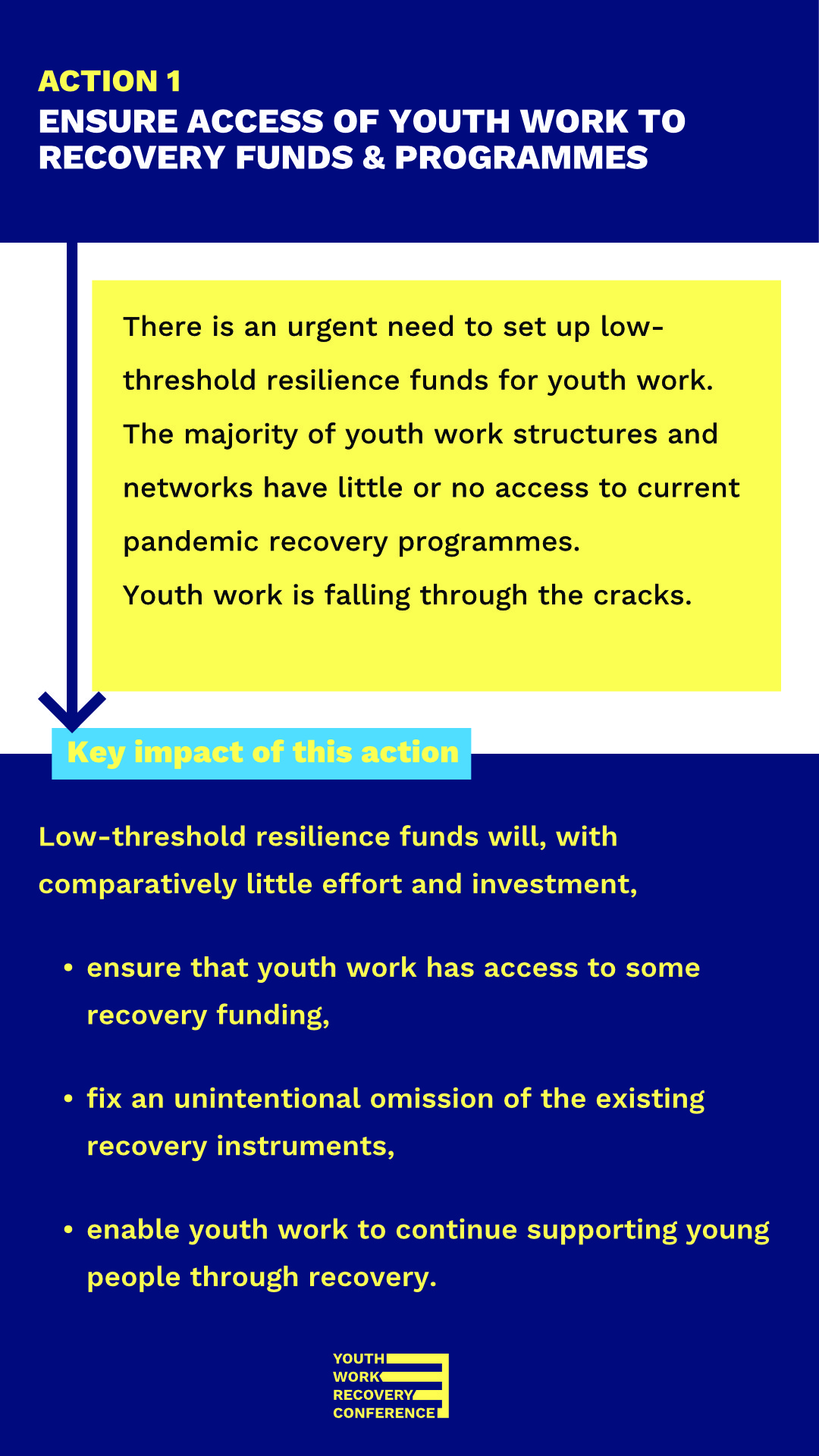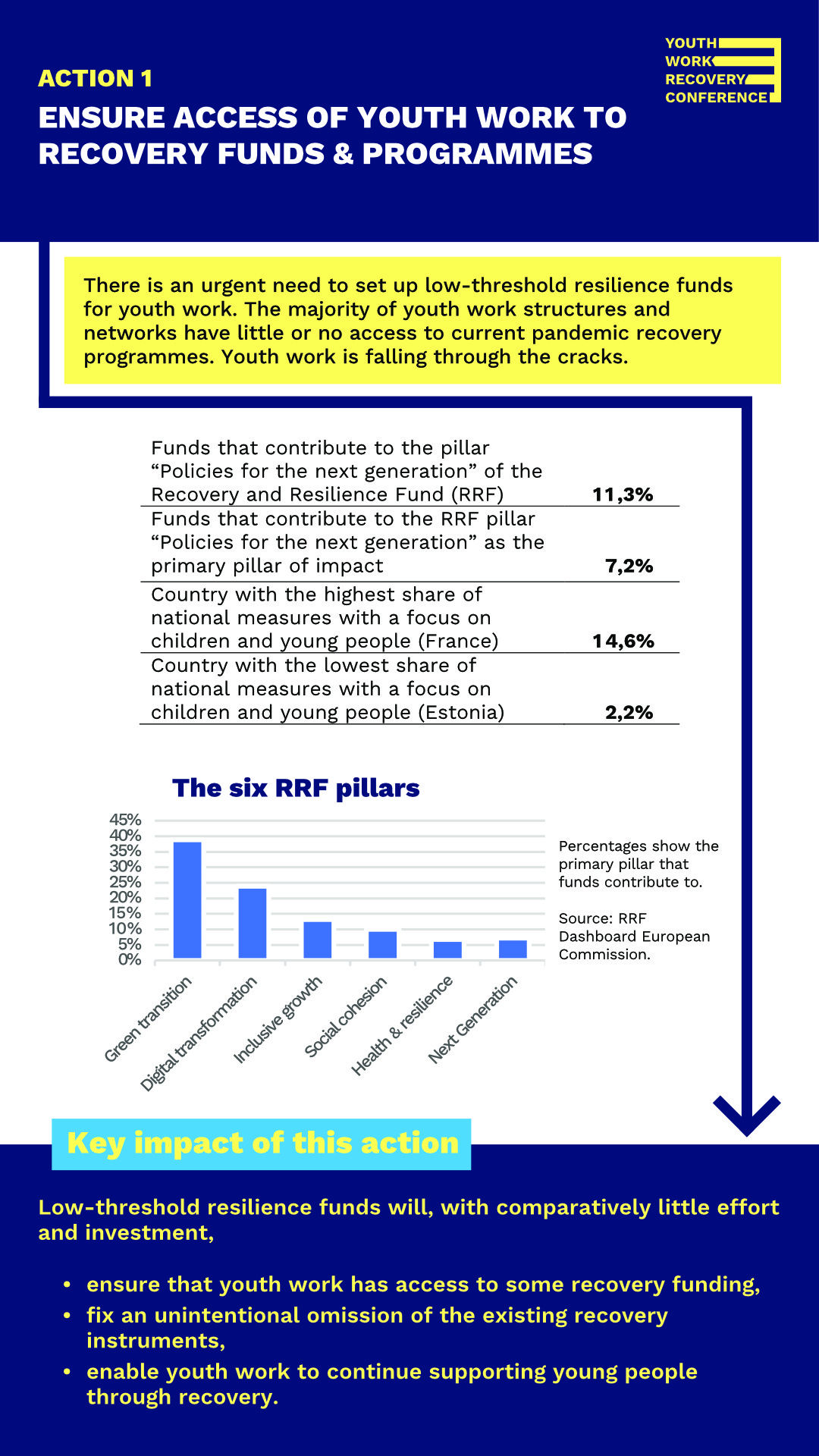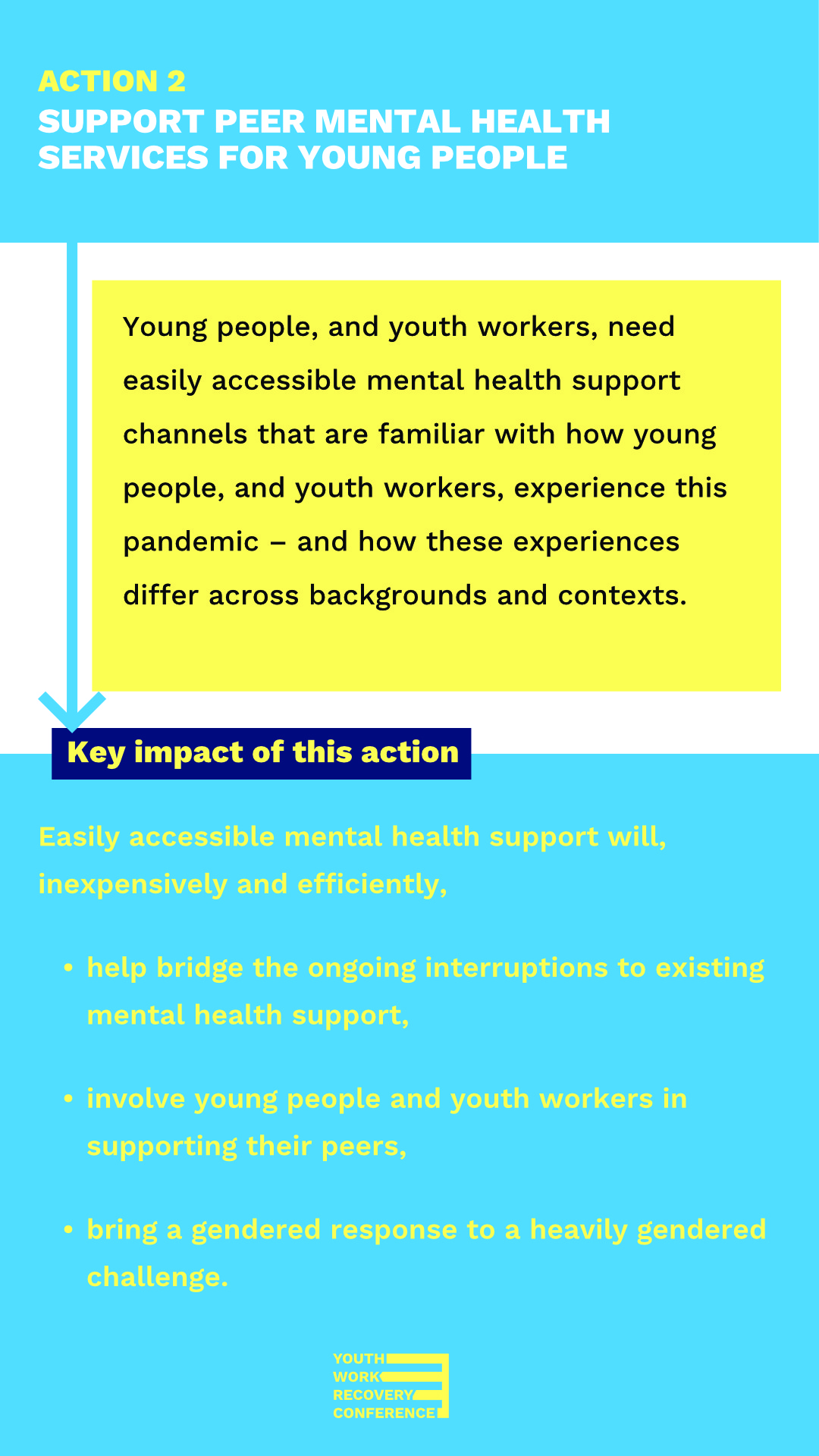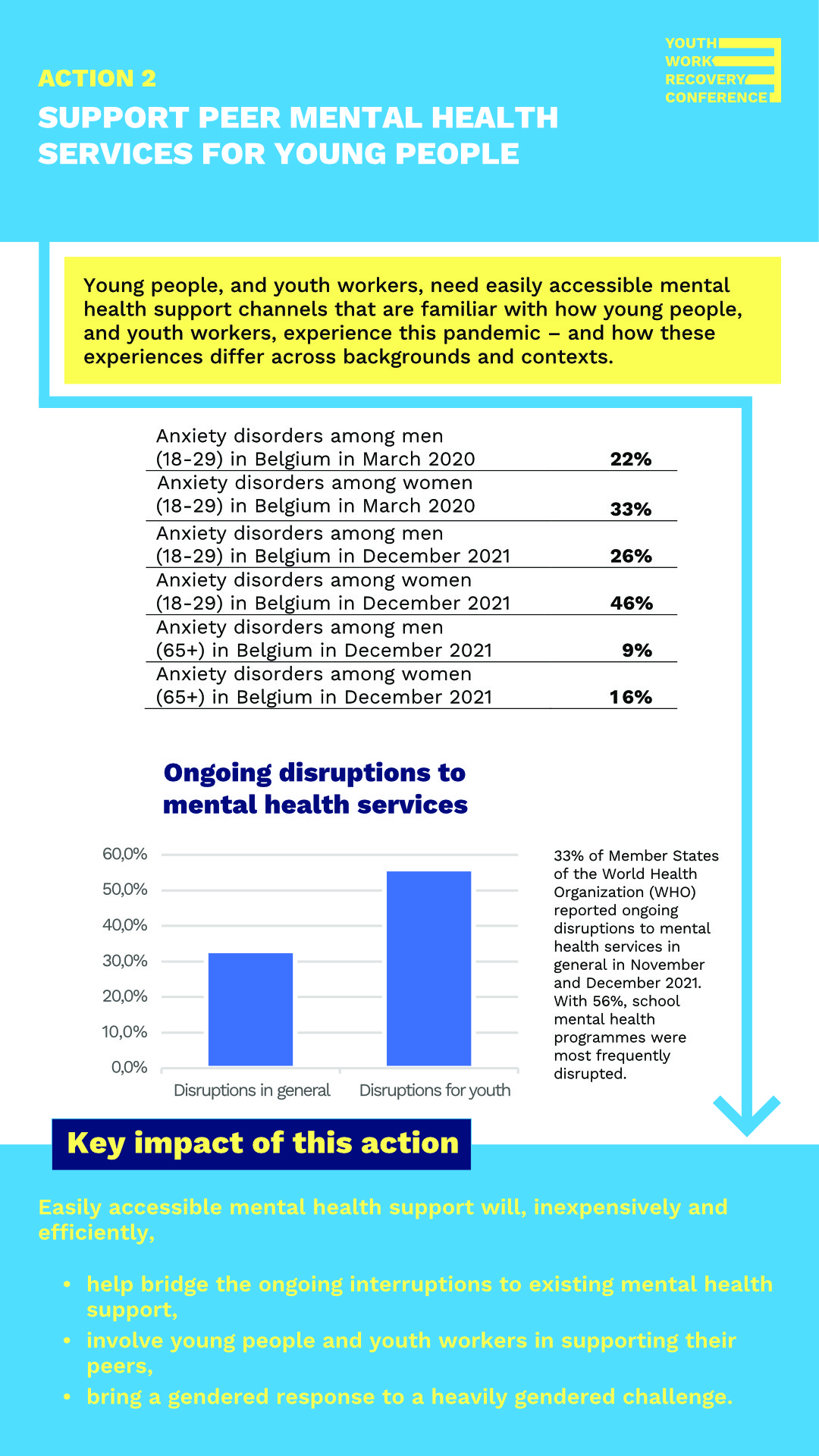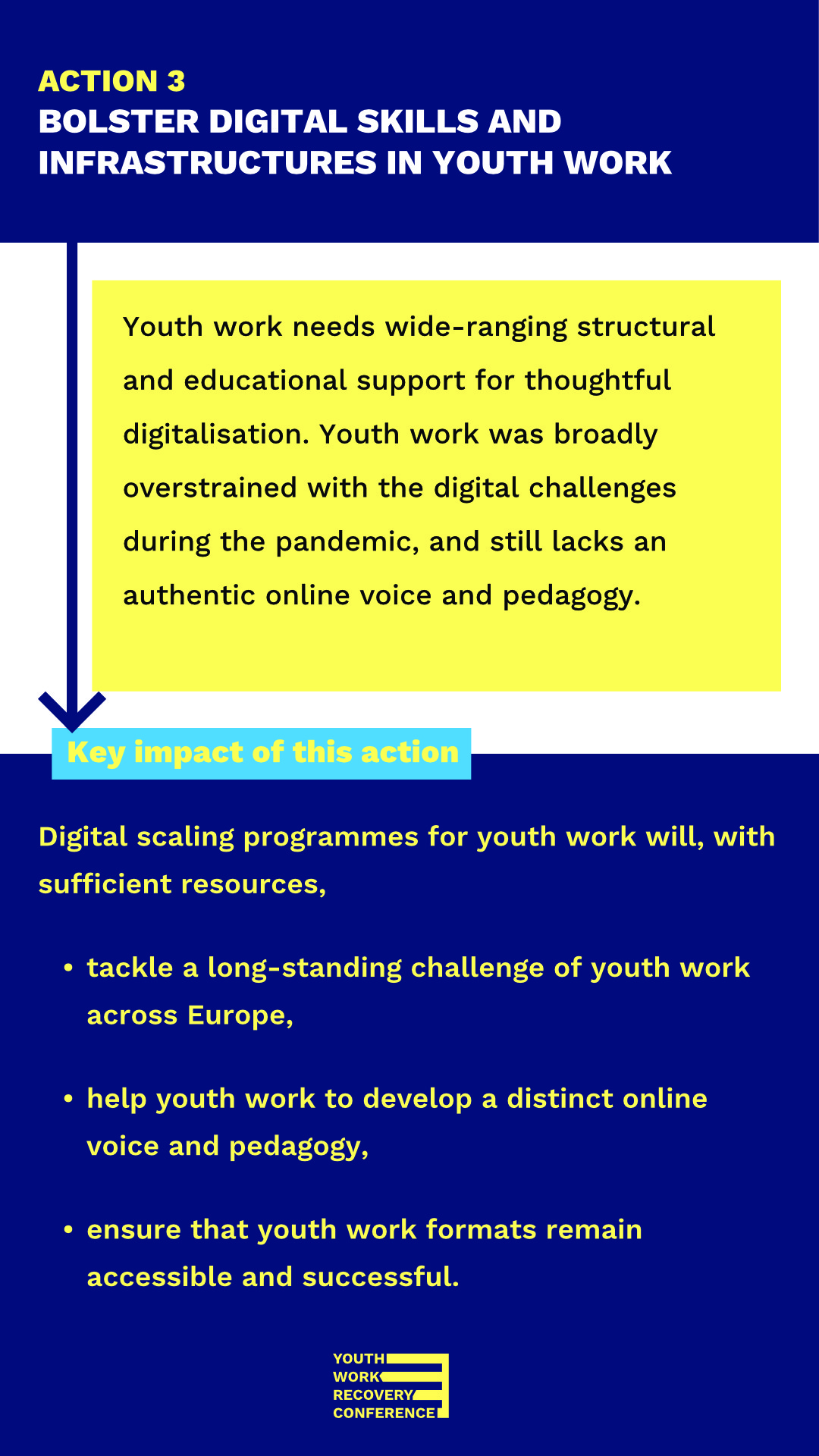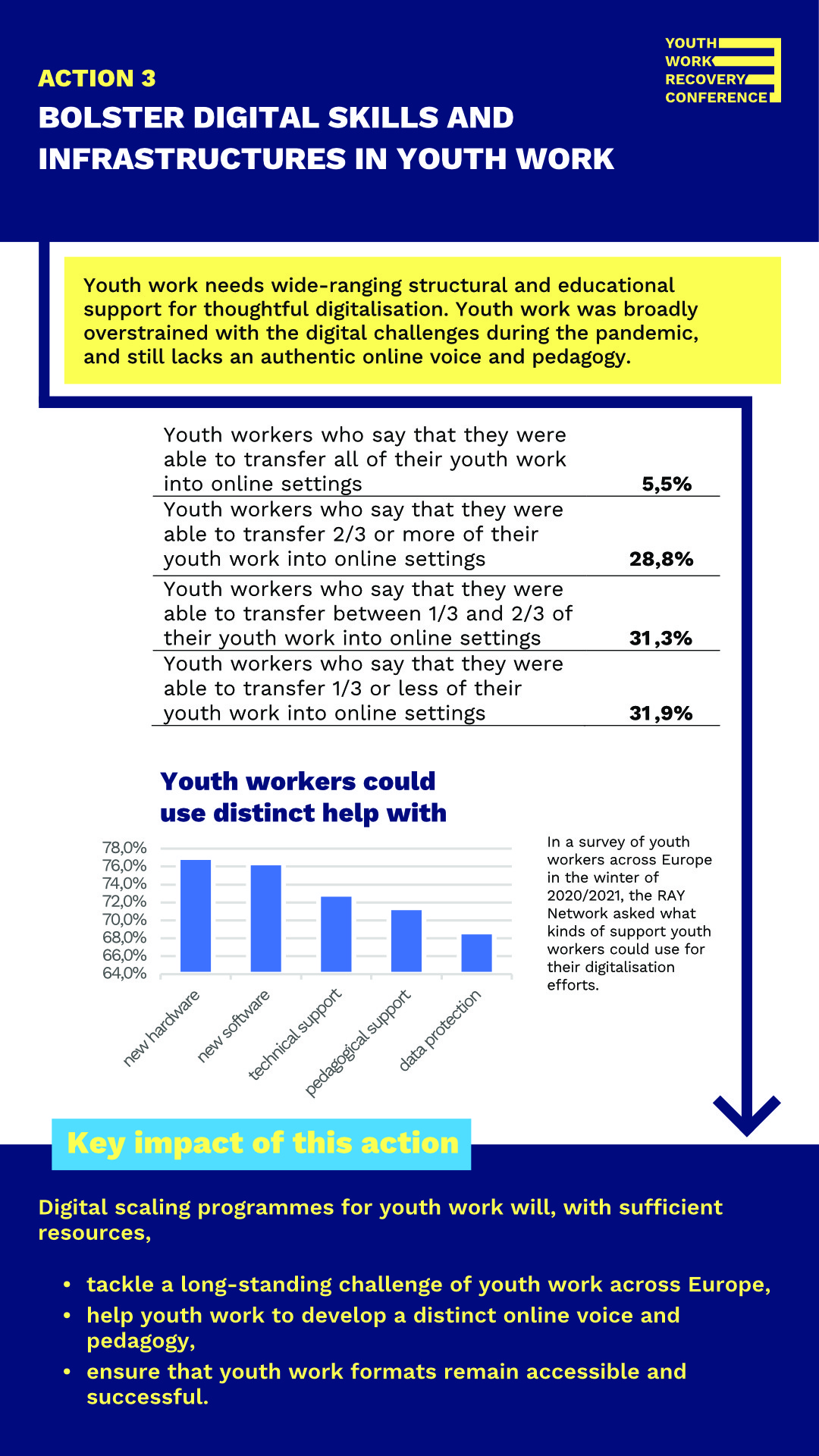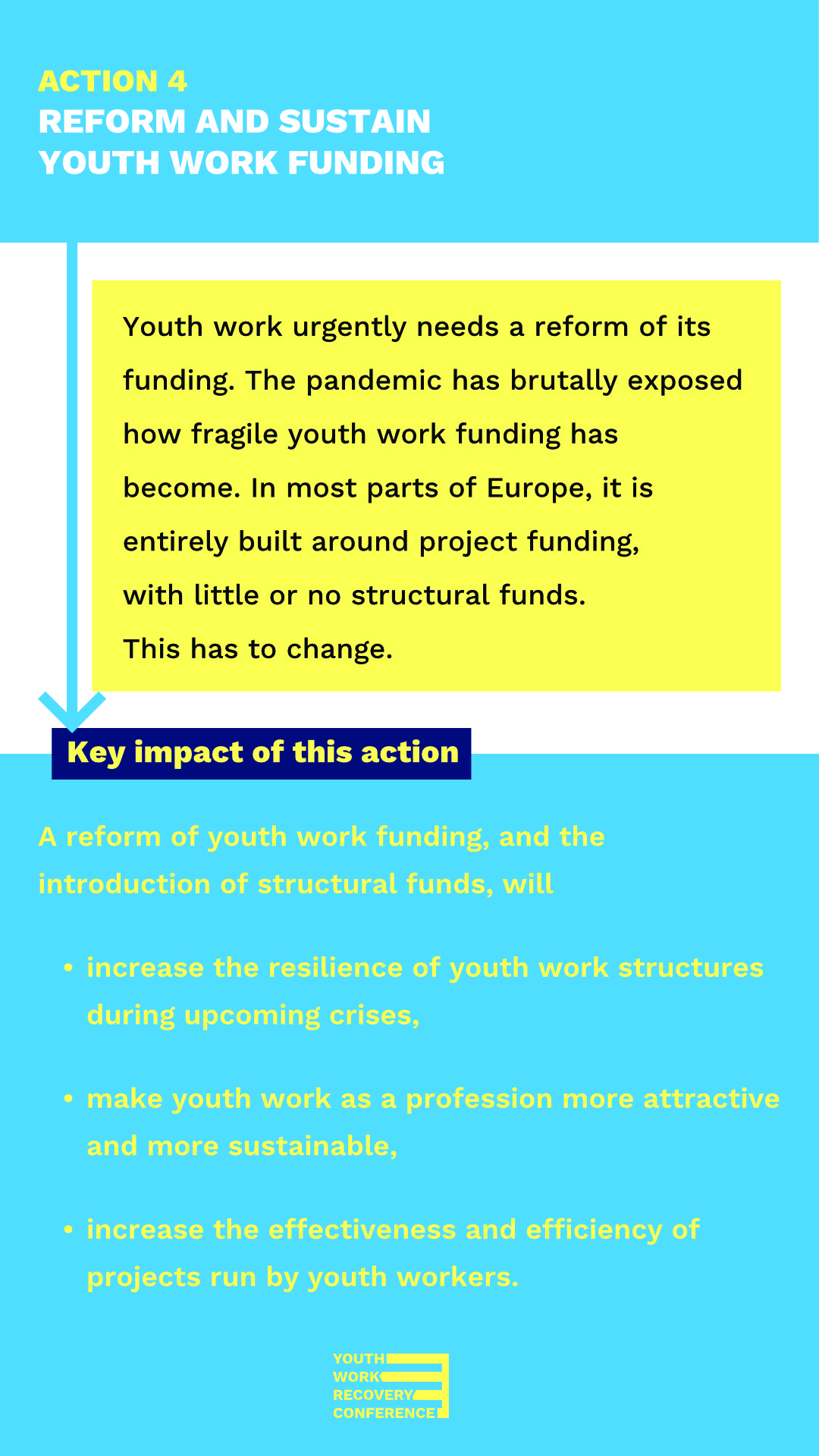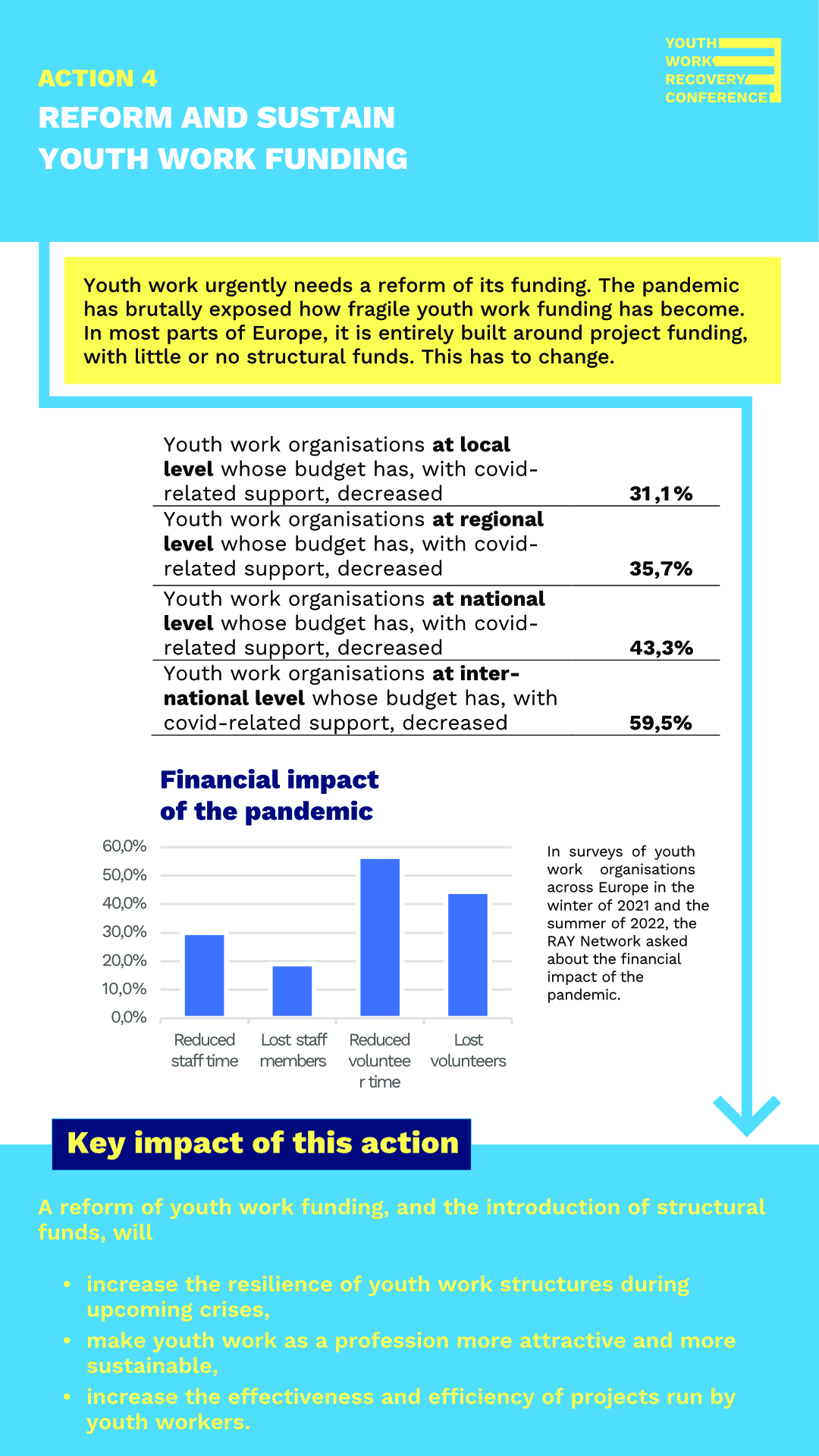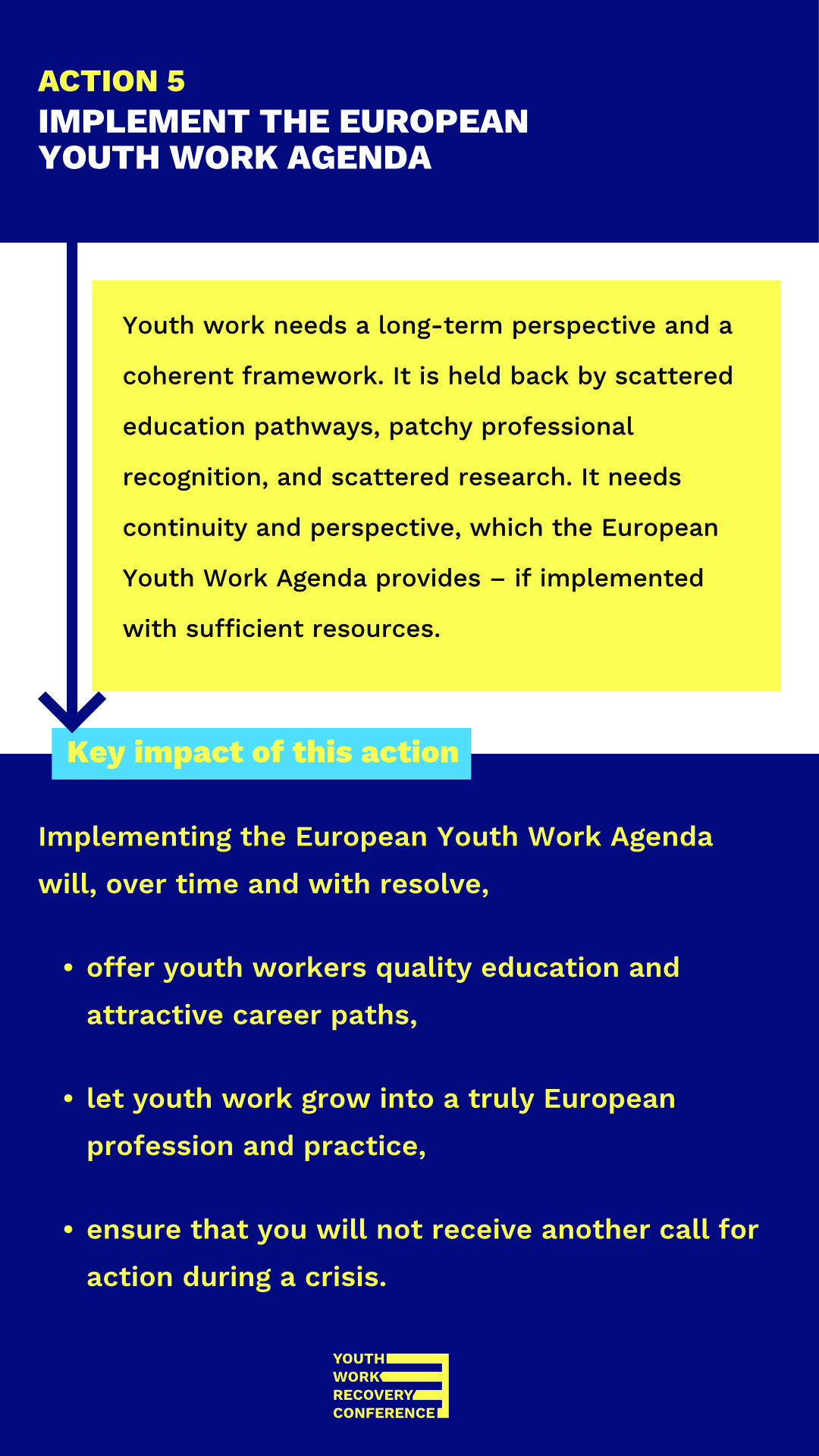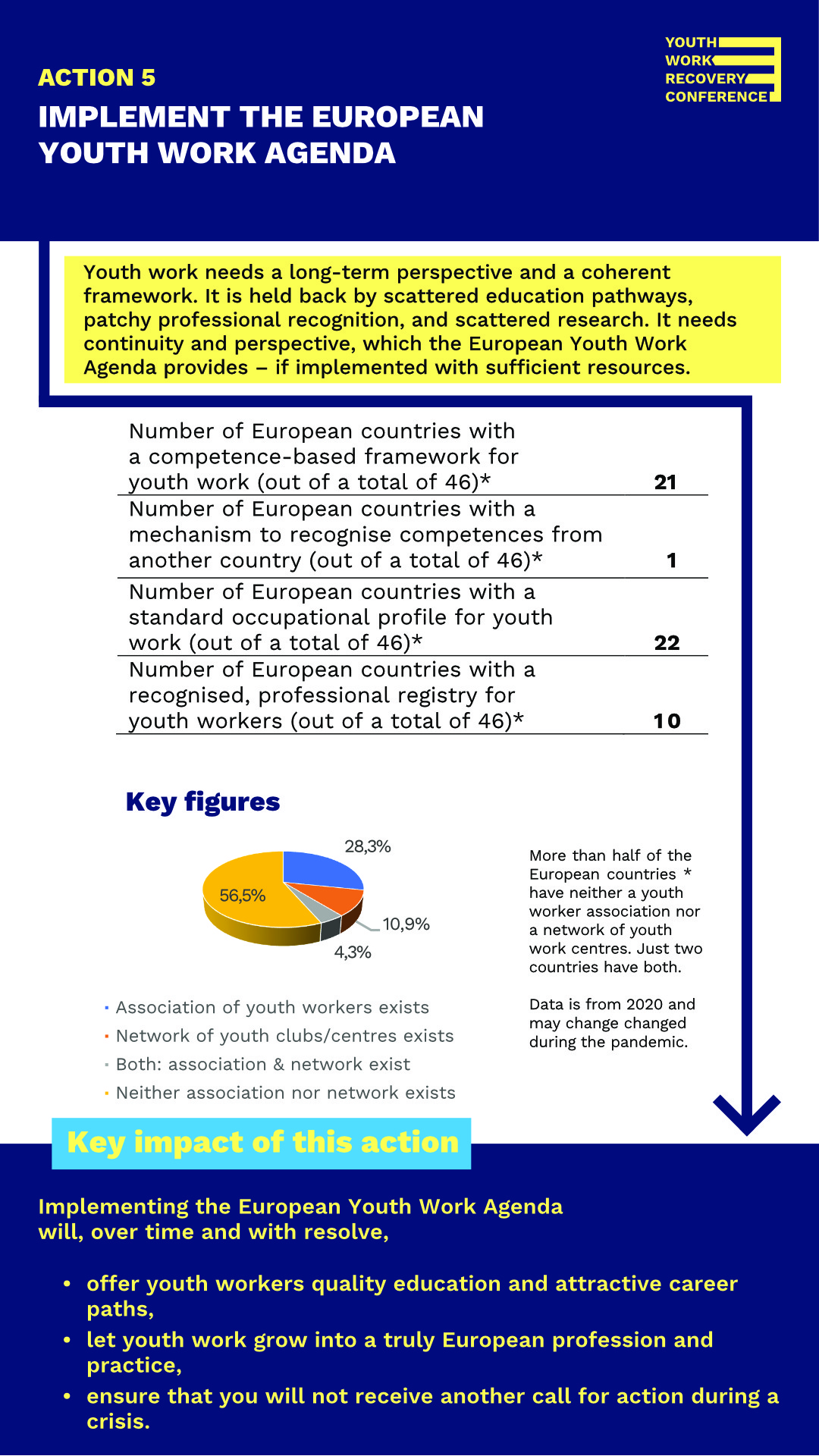Final outcome!
Beyond recovery – CALL FOR ACTION
The final outcome of the Youth Work Recovery Conference, which was held from 13-16 June 2022 in Helsinki, is OUT NOW!
5 ACTIONS for helping the European youth work to recover:
1. Ensure access of youth work to recovery funds
2. Support peer mental health services for young people
3. Bolster digital skills and infrastructures in youth work
4. Reform and sustain youth work funding
5. Implement the European Youth Work Agenda
>> Find the Beyond Recovery Call for Action HERE (pdf)
>> Find out more about the conference, its aims and objectives, inputs and outputs during the conference as well as the process behind the development of the CALL FOR ACTION, HERE.
THE ACTIONS IN MORE DETAIL
1. Ensure access of youth work to recovery funds
There is an urgent need to set up low-threshold resilience funds for youth work. The majority of youth work structures and networks have little or no access to current pandemic recovery programmes. Youth work is falling through the cracks.
A. The main instrument of the EU – the Recovery and Resilience Fund (RRF) – has six pillars. One of them, “Policies for the next generation”, is dedicated to children and young people.
B. The pillar is the smallest of all six pillars, and the majority of the actions, milestones and targets focus on formal education and employment.
C. In a survey conducted in summer 2022, 84% of youth work organisations and networks said they have no access to any kind of recovery funding, whether European or national or local.
D. The main challenges are the foci of the current recovery funds, which do not extend to youth work, and to a lesser extent the eligibility of youth work’s occasionally informal structures.
> Key impact of this action
Low-threshold resilience funds will, with comparatively little effort and investment,
- ensure that youth work has access to some recovery funding,
- fix an unintentional omission of the existing recovery instruments,
- enable youth work to continue supporting young people through recovery.
2. Support peer mental health services for young people
Young people, and youth workers, need easily accessible mental health support channels that are familiar with how young people, and youth workers, experience this pandemic – and how these experiences differ across backgrounds and contexts.
A. Pandemics have larger effects on children and young people, compared to other age groups. The World Health Organization (WHO) speaks of a “youth-specific mental health crisis.”
B. Stress, anxiety, and depression all have strong gendered and socio-economic dimensions.
C. Access to mental health support has been extremely patchy for young people, and mostly non-existent for youth workers, already before the pandemic. Where it existed, it has been heavily disrupted.
D. Peer-support channels have proven particularly effective and are easy and cheap to replicate. Young people, and youth workers, can operate support channels in tandem with and be trained by mental health professionals.
> Key impact of this action
Easily accessible mental health support will, inexpensively and efficiently,
- help bridge the ongoing interruptions to existing mental health support,
- involve young people and youth workers in supporting their peers,
- bring a gendered response to a heavily gendered challenge.
3. Bolster digital skills and infrastructures in youth work
Youth work needs wide-ranging structural and educational support for thoughtful digitalisation. Youth work was broadly overstrained with the digital challenges during the pandemic, and still lacks an authentic online voice and pedagogy.
A. The vast majority of youth workers struggled with the transfer of their youth work formats into the digital realm during the pandemic.
B. This is not a challenge caused by the pandemic, but enflamed by it. Youth work has needed support to develop a distinct online voice and pedagogy for a long time.
C. Youth workers need support with the purchase of adequate hardware and software, with their setup and installation, and with developing sound pedagogical approaches for using them.
D. There are great examples of digital youth work that can be used as a starting point. Youth work needs resources to scale this up across contexts and countries.
> Key impact of this action
Digital scaling programmes for youth work will, with sufficient resources,
- tackle a long-standing challenge of youth work across Europe,
- help youth work to develop a distinct online voice and pedagogy,
- ensure that youth work formats remain accessible and successful.
4. Reform and sustain youth work funding
Youth work urgently needs a reform of its funding. The pandemic has brutally exposed how fragile youth work funding has become. In most parts of Europe, it is entirely built around project funding, with little or no structural funds. This has to change.
A. There is a long, unfortunate history of keeping youth work funding evasive. The result: almost one third of youth work organisations had to reduce their staff time just months into the pandemic. Nearly one fifth had to let staff go.
B. The dependency of youth work on project funding has long been criticised. To this day, however, it has persisted.
C. International youth work has been hit hardest: 60% of youth work organisations active in international youth work have seen their budget shrink due to the pandemic.
D. At local level, the problem is less pronounced, but far from fully resolved: nearly one third of youth work organisations active at local level saw their budget shrink, too.
> Key impact of this action
A reform of youth work funding, and the introduction of structural funds, will
- increase the resilience of youth work structures during upcoming crises,
- make youth work as a profession more attractive and more sustainable,
- increase the effectiveness and efficiency of projects run by youth workers.
5. Implement the European Youth Work Agenda
Youth work needs a long-term perspective and a coherent framework. It is held back by scattered education pathways, patchy professional recognition, and scattered research. It needs continuity and perspective, which the European Youth Work Agenda provides – if implemented with sufficient resources.
A. Education and training for youth workers is scattered. Just 14 EU member states have university degree courses for youth work.
B. Recognition of youth workers remains patchy. There are few standard occupational profiles, and career paths for too many youth workers are obscure.
C. Youth work research is too scattered. It lacks academic integration and infrastructure.
D. The European Youth Work Agenda provides a long-term policy framework for youth work. Institutional support is readily available to implement the Agenda in your context.
E. Reach out at any time!
> Key impact of this action
Implementing the European Youth Work Agenda will, over time and with resolve,
- offer youth workers quality education and attractive career paths,
- let youth work grow into a truly European profession and practice,
- ensure that you will not receive another call for action during a crisis.
We call out to decision-makers in administration, policy and politics across Europe- it is time for ACTION!
THE CONTEXT OF THIS CALL FOR ACTION
In June 2022, the Youth Work Recovery Conference brought policy, practice and research together to discuss the effects of the coronavirus pandemic and crisis on the field of youth work, and its respective actors, across Europe. The Youth Work Recovery Conference explored the evidence on the needs for support of youth work in Europe, on the one hand, and the available support options for youth work in Europe, on the other hand. It identified key gaps in the obtainable support measures, as well as specific and concrete support mechanisms needed in addition
to existing ones. The more than 100 attendees of the Youth Work Recovery Conference formulated clear calls for action. These outcomes were distilled into five core actions to help European youth work through and beyond recovery.
Visuals for the 5 ACTIONS
